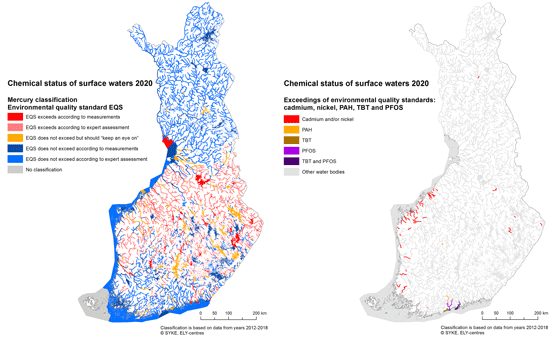Press release 2020-08-28 at 9:24

PBDE exceeds its environmental quality standard everywhere in Finland but it is not shown on the surface water chemical status maps.
Open a bigger version of the maps (jpg 1 Mb).
The chemical status of Finnish lakes, rivers, and coastal waters has not yet improved, despite the concentrations of several chemicals falling below the limits set for them (EQS - Environmental Quality Standards). As the quality standards for a few permanent and bioaccumulative substances are exceeded throughout Finland, the chemical status of Finnish surface water is rated as poor.
The Centres for Economic Development, Transport and the Environment (ELY Centres) and the Finnish Environment Institute assess the chemical status of Finnish surface waters every six years. The status assessment compares the concentrations of substances hazardous and harmful to the aquatic environment with their respective EQS, which are based on their toxic effects. The assessment covers a total of 6,875 water bodies, which are spread across the whole of Finland.
Mercury a common cause of poor water status
The concentration limit set for mercury was exceeded in approximately half of the water bodies assessed. The outcome of the current classification remained largely the same as in the previous classification period. The amount of mercury is estimated by way of its concentration in fish, but the concentration limit set for the assessment of the chemical status of water bodies is significantly stricter than the maximum level set for fish when sold as a foodstuff.
Mercury is a long-range transported heavy metal derived from the combustion of fossil fuels, especially coal. The use of mercury and mercury emissions are restricted by international agreements. However, water recovery is expected to take decades or centuries, as current deposition is very low compared to the amount of mercury already present in soils and sediments.
Concentrations of flame retardant chemicals widely exceeded EQS values
Although the EQS for polybrominated diphenyl ethers (PBDEs), previously used as flame retardants, was tightened in 2015, the concentration limit was exceeded throughout Europe. PBDEs are long-range and very persistent compounds. With a few specific exceptions, their use is internationally prohibited. The EQS has been criticised for being too strict. Food authorities do not impose a threshold value for PBDE concentrations in fish.
Few compounds exceed EQS limits
Concentrations of nickel and cadmium exceeded their EQS limits/values in approximately 40 Finnish water bodies. The EQS for organotin compounds (TBT), perfluorooctane sulfonate (PFOS), and polycyclic aromatic hydrocarbons (PAHs) were exceeded in fewer than 10 water bodies.
Classification of chemical status as a basis for water management plans
The recently completed chemical status classification of surface waters and the ecological status and groundwater status classifications completed in 2019 will be used as a basis for planning water management measures for Finland’s third water management period (2022–2027). The aim of these plans is to improve the status of all water bodies. The public consultation on the water management plans is set to commence on 2 November 2020.
Further information
Katri Siimes, Researcher, Finnish Environment Institute (SYKE), tel. +358 29 525 1637, firstname.lastname@ymparisto.fi
Jaakko Mannio, Principal Scientist, Finnish Environment Institute (SYKE), tel. +358 29 525 1406, firstname.lastname@ymparisto.fi
Water management area coordinators
River Vuoksi area: Juho Kotanen, ELY Centre for South Savo, tel. +358 29 502 4192, firstname.lastname@ely-keskus.fi
River Kymjoki-Gulf of Finland area: Antti Mäntykoski, ELY Centre for Uusimaa, tel. +358 29 502 1434, firstname.lastname@ely-keskus.fi
River Kokemäenjoki-Archipelago Sea-Bothnian Sea area: Vincent Westberg, ELY Centre for South Ostrobothnia, tel. +358 29 502 7956, firstname.lastname@ely-keskus.fi
River Oulujoki-River Iijoki area: Anne Laine, ELY Centre for North Ostrobothnia, tel. +358 29 502 8363, firstname.lastname@ely-keskus.fi
The Kemijoki, Tornionjoki, Teno, Näätämöjoki, and Paatsjoki river areas: Pekka Räinä, ELY Centre for Lapland, tel. +358 29 502 2389, firstname.lastname@ely-keskus.fi
Maps
PBDE exceeds its environmental quality standard everywhere in Finland but it is not shown on the surface water chemical status maps.
Map 1/2: Chemical status of surface waters: Mercury classification
Map 2/2: Chemical status of surface waters: Cadmium, Nickel, PAH, TBT, and PFOS
Links
Harmful substances in Finnish water bodies: situation and monitoring guidelines report (in Finnish but extended summary in English)
Safe use of Fish (Finnish Food Authority)
State of the surface waters